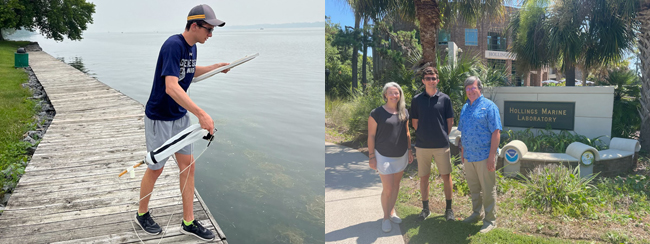
(At left) New York Sea Grant summer intern Micah Ford deploys water sampling gear along Oneida Lake. Credit: Cornell/Jim Watkins; (At right) At NOAA’s Hollings Marine Laboratory, New York Sea Grant summer intern Micah Ford met with Phytoplankton Monitoring Network Coordinator Jennifer Maucher Fuquay and Research Oceanographer Steve Morton, Ph.D. Credit: NOAA
Contacts:
Stacy Furgal, New York Sea Grant Great Lakes Fisheries Specialist, E: slf85@cornell.edu, P: 315-312-3042
James Watkins, Ph.D., Cornell Biological Field Station on Oneida Lake Associate Director, Cornell University, P: 315-378-8115
Kara Lynn Dunn, NYSG's Freelance Great Lakes Publicist, E: karalynn@gisco.net, P: 315-465-7578
Bridgeport, NY, October 19, 2023 - Through summer internships and fellowships with New York Sea Grant (NYSG) two undergraduate students – Micah Ford of Arkport, New York and Krystal Dixon of New Hampton, New York – gained real-world experience with environmental science at the Cornell Biological Field Station on Oneida Lake.
“These student learning experiences with New York Sea Grant and its partners provide excellent learning and career-building opportunities for students interested in environmental science, from fisheries and aquatic sciences to coastal policy and community development,” said New York Sea Grant Associate Director Katherine Bunting-Howarth, Ph.D., J.D.
During his internship on Oneida Lake, Micah Ford, a SUNY Geneseo junior, used microscopy to analyze changes in the abundance and species of phytoplankton, including cyanobacteria, that can cause harmful algal blooms (HAB) in the lake. Ford developed educational materials to assist citizen scientists with the National Oceanic and Atmospheric Administration (NOAA) Phytoplankton Monitoring Network (PMN), a nationwide, community-based effort by volunteers monitoring marine and freshwater phytoplankton and HAB. Ford’s internship also included the opportunity to visit the home of the PMN at NOAA’s Hollings Marine Laboratory in Charleston, South Carolina, for a week.
Ford is a biology major with an interest in environmental health. His fellowship was part of the NOAA Community Engaged Internship program.

New York Sea Grant fellow Krystal Dixon, left, a Cornell University Environment and Sustainability major, with New York Sea Grant Great Lakes Fisheries and Ecosystem Health Specialist Stacy Furgal along Oneida Lake. Credit: R.J. Anderson/Cornell University; (Inset) Dixon, a Cornell University Environment and Sustainability major, is seen here at the NYS DEC Oneida Lake Fish Hatchery with a sturgeon wall mural. Credit: Stacy Furgal/NYSG
While stationed at the Cornell Biological Field Station on Oneida Lake, Cornell University rising senior Krystal Dixon assisted researchers with lake sturgeon sampling and laboratory analysis to better understand the large fish’s diet. Dixon developed public education materials related to lake sturgeon restoration efforts in New York state. The materials include an age-to-length relationship key that can be used for estimating the age of lake sturgeon in Oneida Lake in comparison to sturgeon found in other New York waters, including Onondaga Lake and the Niagara River.
Dixon is an environment and sustainability major. Her internship was made possible through the Cornell Cooperative Extension Summer Internship Program.
NYSG Great Lakes Fisheries and Ecosystem Health Specialist Stacy Furgal, Cornell Biological Field Station on Oneida Lake Associate Director and Cornell University Natural Resources and the Environment Senior Research Associate James Watkins, Ph.D., and Senior Research Associate Zoe Almeida, Ph.D., mentored the summer interns.
“This internship experience provides students with hands-on opportunities to learn about New York’s fish communities and the aquatic food web as well as the ecological interactions in New York waters and innovative technologies supporting research that informs management of the Great Lakes and its watershed,” said Watkins.
“The educational resources developed by Micah and Krystal will help advance the public’s understanding of the environmental value of New York waters, particularly in the Great Lakes watershed. Micah’s project contributes to providing an avenue for the community to directly participate in citizen science. The materials Krystal developed add to statewide efforts to teach the public about lake sturgeon conservation, life history, and research,” Furgal said.
The Cornell Biological Field Station on Oneida Lake at Shackelton Point addresses the issues of changing aquatic ecosystems in New York state and beyond. Research encompasses such concerns as fisheries sustainability, invasive species, and climate change impact on the aquatic ecosystem. Ten or more undergraduates are summer interns here each year. Learn more at Cornell CALS "Cornell Biological Field Station at Shackelton Point" website.
More Info: New York Sea Grant
New York Sea Grant (NYSG), a cooperative program of Cornell University
and the State University of New York (SUNY), is one of 34 university-based
programs under the National Oceanic and Atmospheric Administration’s
National Sea Grant College Program.
Since 1971, NYSG has represented a statewide network of integrated
research, education and extension services promoting coastal community
economic vitality, environmental sustainability and citizen awareness
and understanding about the State’s marine and Great Lakes resources.
Through NYSG’s efforts, the combined talents of university scientists
and extension specialists help develop and transfer science-based
information to many coastal user groups—businesses and industries,
federal, state and local government decision-makers and agency managers,
educators, the media and the interested public.
The program maintains Great Lakes offices at Cornell University, SUNY
Buffalo, SUNY Oswego and the Wayne County Cooperative Extension office
in Newark. In the State's marine waters, NYSG has offices at Stony Brook
University and with Cornell Cooperative Extension of Nassau County on Long Island, Brooklyn College and Cornell Cooperative
Extension in NYC and Kingston in the Hudson Valley.
For updates on Sea Grant activities: www.nyseagrant.org has RSS, Facebook, Twitter, Instagram, and YouTube links. NYSG offers a free e-list sign up via www.nyseagrant.org/nycoastlines for its flagship publication, NY Coastlines/Currents, which is published quarterly.